The Gap review
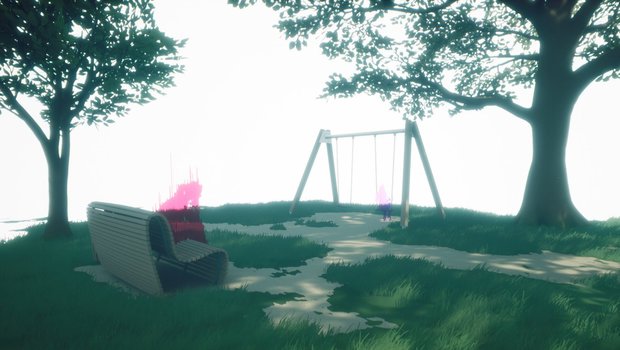
- 0 Comments
Emotionally powerful narrative adventure is light on gameplay but its character-driven investigation should leave any story fan fulfilled
In 2021, I was diagnosed with multiple sclerosis. For a couple of years, I found myself shying away from any media that had neurodegenerative disease as a theme. This was partly due to my unwillingness to be confronted with my personal reality, and partly because I found that media often treated it as an extremely tragic trope, with character identities reduced to ‘the disease’ and their more noticeable symptoms used as a shock factor, while everyone around them spoke in hushed tones with sorrowful faces. These depictions of illness can be inaccurate, or at the very least overly stereotypical. I no longer avoid such games, however, and have been pleased to see that some have started to treat the subject more thoughtfully. So when the opportunity arose to play The Gap, a game that centres around dealing with a neurological disorder, I was eager to check it out, though still with some trepidation.
It turns out there was no reason for concern. The Gap, the first game from Slovenian developers Label This, is a sci-fi-influenced psychological first-person narrative adventure. It features some light puzzle solving as well, but the game’s true strength lies in the emotional but not heavy-handed story of one man’s search for the cure of a rare disease. In doing so, it delivers an experience above and beyond what I expected and left me with a lingering feeling of unsettling introspection long after I finished.
The opening cinematic is striking, completely dark except for some stylish dialogue on-screen. A voiced conversation between two characters is fraught, tense, desperate. One voice is pleading and emotional, the other defiant and unwavering. The first belongs to our player character, Dr Joshua Hayes, an exceptionally gifted and accomplished neuroscientist who is desperately trying to reason with his wife Amber. Amber is tired of his delusions, his parental neglect of their child, and his emotional unavailability, but Joshua claims he’s ‘so close’ to something, begging for another couple of weeks.
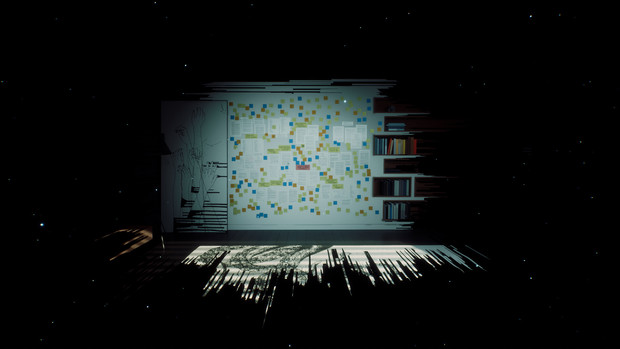
On the surface, this presents like marital disharmony stemming from a lack of communication, but it doesn’t feel like that’s the entire story here – something ominous is lurking, something that will dutifully unfold as the narrative does. The interaction feels uncomfortable; the pitch-black environment enveloping the voices feels oppressive but also liminal, doing an excellent job of setting the scene. Following a trail of light sparks when it’s over, we find ourselves in a long, dark corridor, lit partially by a bright light in the distance and streaks of white heading in that direction. Joshua’s internal monologue reveals that he is frustrated and deflated but keeps reiterating that he is close, wanting to prove Amber wrong.
The light at the end of the tunnel turns out to be a huge whiteboard filled with notes and articles. There’s no time to investigate, however, save for a Polaroid and a few scattered papers, as the light sparks urge Joshua forward through another dark space towards the next bright light. Joshua’s monologue becomes more confusing and disjointed, expressing concern that it is a miracle he even remembers who he is. When Joshua comes upon a computer and accesses it, The Gap’s first full chapter finally melts into view.
It's April 24, 2045, and we’re in Joshua’s home. The apartment is in shambles with empty food containers everywhere, smashed family pictures on the floor, bits of paper and photos strewn about, and some sinister words spray painted on the wall and door. A voicemail is left by someone who sounds extremely worried about Joshua and his lack of contact. It is safe to say that Joshua is a troubled man, and it’s the player’s task to find out why and what we can do to remedy this situation.

At its heart, The Gap is an investigation game that offers little to no explanation or clear direction. In many games a lack of guidance can be irritating but not so here – a testament to how worldbuilding that’s subtle and vague can be powerful if handled properly. With no task list or journal and surrounded by mess, the lone key to this entire mystery is a huge wall with scribbles and diagrams and lots of empty spaces, inviting us to uncover the missing details. The wall is not dissimilar to a detective’s pinboard where photos and notes are connected by red string, only this one is in Joshua’s fervent handwriting and thick marker strokes, which gives it a chaotic yet still strangely organised appearance. It’s also mostly empty to start, apart from the phrase ‘The Cure’ placed directly in the middle.
The wall of clues also has a section five lines deep that looks like a timeline. The left is titled ‘memories’ and the right is labelled ‘reality.’ Upon clicking that brightly highlighted phrase in the middle of the wall, we are transported to a flashback of Joshua tearing down the same whiteboard of notes from earlier. More importantly, when we return from the memory, a Polaroid picture of it has appeared on our wall and is now checked off. Looking around some more, Joshua’s latest neuroscience research is revealed: He’s been trying to access alternative realities by observing the changes in brain waves when experiencing déjà vu. Incredibly, he has found that these changes create a brief gateway into a parallel universe. However, it can only be accomplished when an event or observed image in the present universe is the same or very similar in the parallel one.
This, if it can be proved, would be the biggest scientific and philosophical discovery of our time, proving the concept of multiverses and leading to seismic shifts in the world as we know it. Joshua’s goal isn’t as grand as this, though – it is simply to find ‘The Cure,’ which he is sure exists in a parallel universe and he will find if he keeps pursuing it aggressively. We soon learn, though, that to supplement his research, Joshua has signed up for a shady experimental nanobot technology developed by a biotech giant that promises to repair and prevent damage caused by neurodegenerative diseases. I found this really sold the ‘near future’ aspect of The Gap, and it resonated deeply with me. The nanotechnology feels like it’s just a step or two from where we are now, which is exciting but at the same time terrifying, and I felt a chilling sense of dread when Joshua signed the NDA before his operation.
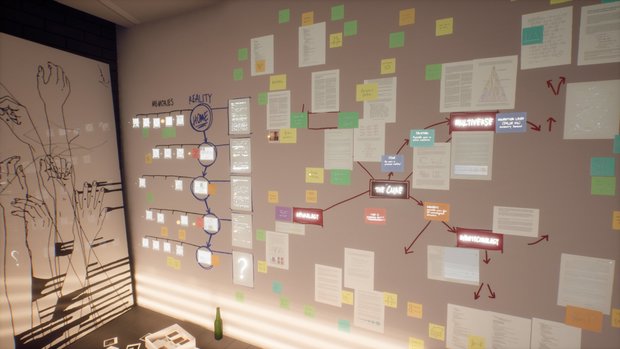
It’s not a spoiler to say that ‘The Cure’ pertains to a rare genetic neurological disorder that is affecting Joshua’s family. I’m being deliberately vague on who and why, however, because that isn’t made explicitly clear until later. But as a genetic illness, it is incurable (in Joshua’s universe) and the prognosis is bleak, making the protagonist’s research feel desperate and impassioned.
Once this background is uncovered, our objective feels much clearer. We must view objects in the environment that might trigger memories and potentially lead to a parallel universe. Some of the things we can interact with are simply standalone clues: an empty pill bottle on the floor, a text conversation between Joshua and his wife, or more disturbingly, a child’s drawing with the faces scratched out. However, many of the things we can interact with are connected to significant memories for Joshua across five different time periods, starting from when he was a hopeful young man beginning college. Holding such items for a moment initiates memory flashbacks, as indicated by a slick transition on-screen. Some memories are part of a pair, and finding the first item will only tease us with a blurry outline of what we’re trying to uncover. When we place the item back down, a lock symbol signals that we need to find the other piece of this specific memory.
This is where things got a bit dicey for me, as whenever I went further into a scene, I worried about what I had missed in a previous space. I just wanted to look at an email, for example, but inadvertently triggered another different flashback that took me away from my original scene and all of its remaining unexamined clues, with no clear way to get back to where I was. If that sounds confusing, it’s because it is! However, as I discovered (much!) later, once you access a memory, it appears as a Polaroid on your wall of clues and Joshua can jump straight back into it any time. You can also utilise a ‘leave’ function at any time, which exits your current scene and transports you back to the present day in front of that memory map. If you manage to fully complete and explore a memory, the present day swirls back into view and you’ll find a check mark next to its Polaroid on the wall.
It is painfully obvious that no one other than Joshua occupies the apartment in his current reality, and a lot of his memories are bittersweet. We are privy to deeply personal moments, like the time he met his future wife, their wedding day, and pushing his young daughter on the swing. We are also uncomfortable observers of the family’s disagreements and painful discoveries. It’s hard not to feel connected to a character when viewing the most influential experiences that make a person who they are. Then there are the memories that revolve more around the (very real) disease at the heart of the story, which can be hard to watch but feel authentic and raw without being emotionally manipulative.
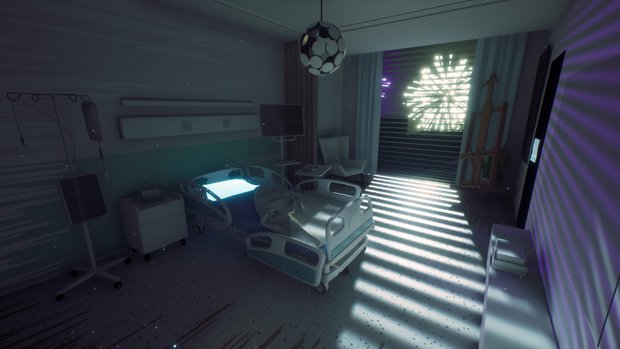
Narratively, everything reveals itself at a calm pace, slowly heading towards the final pieces of the wall coming together. The clues and memories can be accessed nonlinearly within a chapter, however, so you may encounter things out of chronological order. There is no penalty for this, but it might take a moment to think about where something comes on the timeline. Helpfully, they'll all be automatically added to your map in the correct order. There are a couple of twists and turns in the plot that are alluded to in certain early memories, which keeps the story interesting in a constant flurry of new information being unlocked, and will make us view things in a different light than we previously did.
The Gap looks very polished, utilising a full 3D engine that lets you freely explore. The backgrounds feel modern, clean and somewhat minimalist, with a muted blue and grey colour palette across most scenes. It also uses wide swathes of black in memory scenes that seem to sweep across the room, giving an eerie space-like vacuum feel; dark, empty and unsettling. Turn away from the scene and you’re met with only an endless black void that made me anxious, as if I was just floating.
The most eye-catching part the game’s graphical style is its dialogue, which is brilliantly done and beautifully distinct. Instead of a traditional text box, dialogue is displayed on-screen in large font and bright colours as the spoken lines are delivered. The words zoom into view from the bottom of the screen to a place in the middle, and each speaker is clearly indicated with a different colour of text. Joshua’s internal monologue is presented in a bright italic script, but normal conversation is in a standard font that is easy to read. It all feels very sci-fi, like we are viewing it in VR, because the text stays static but Joshua can move around and behind it and explore the scene without the game pausing the conversation.
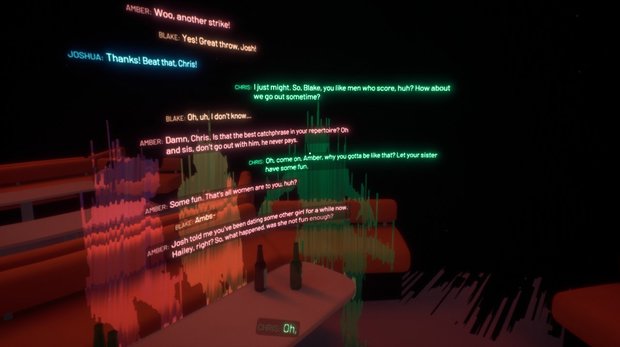
Sound design is understated here, presenting in the earlier segments as atmospheric ‘noise’ like that of a fan or the sound of rain. There are also extended periods of silence, which feels perfectly placed here as we navigate Joshua’s cold and empty apartment. Many of the memories and realities have ambient sound heard crisp and clear, like one at a farm filled with the chirps of birds and rustling of leaves.
Music is featured mainly as ambient background when it plays, though a dramatic swell complements the transition into memories, which feels a bit uncomfortable, like we are accessing something hidden and otherworldly. In one memory of Joshua attending a gig with his friend, the track utilises a bold bass line and drumbeat, and the voice-overs reflect having to shout over the music. The voice work is excellent, and considering the game’s subject matter, not over the top. Joshua can be calm, contemplative and possibly a little depressed; more energetic and frustrated when in a high-stress conversation; or filled with pain and vitriol towards himself when detailing his ‘failures.’
The Gap contains a significant number of scientific papers, notes and concepts, but they are written in a way that is easy to understand. At one point we access a memory about Joshua’s extremely easy (multiple choice) final exam at college, which, if we’ve been paying attention to clues scattered around, is a breeze. It’s one of the game’s rare puzzles, which some players may find disappointing, but this is nothing new in primarily narrative-driven games that prioritise immersion through exploration and environmental storytelling.
The puzzles that do exist mainly involve finding combinations to unlock phones and tablets in memories, but a few are based on clues you pick up along the way. One sombre puzzle sees Joshua at the pharmacy picking up important medication, which requires information found in text messages and emails, and the names of various pill bottles found scattered around. However, these clues are dispersed in different memories, at different parts of the game. Fortunately the game makes it very clear if you are accessing a memory that you don’t have all the information for. I found this helpful, as I went enthusiastically into the pharmacy memory sure that I had everything I needed and ready to shop but was quickly informed that I didn’t. There is no penalty for being unable to complete the puzzle objective; you’re simply kicked out to try again later.
The game is Steam Deck verified and worked like a dream for me, but I would have loved to see more accessibility options, such as a larger central reticle (it is VERY small!) and text size slider. There is a zoom-in ability, but it really doesn’t make too much difference. One thing that is included is the option to change the ‘hold to access’ button to a single tap, which is certainly helpful in the case of some motor difficulties. Perhaps I’m being idealistic here, but I think for a game about neurological disorders, it would have been incredible for the game to showcase more accessibility than that.
I completed The Gap in around two and a half hours, which is short but it felt much longer (in a good way). I wanted to absorb every conversation and every email and text, because I felt like I also was really traversing the years of Joshua’s life right along with him. I would say I really enjoyed playing the game, though that feels like an odd way to describe such an uncomfortable and moving experience. Games like this are important, focusing more on the personal strain of illness and how it affects people, rather than simply using it as an unpleasant or exploitative plot device. The writers here have handled this theme carefully and with tact, and despite its more solemn tone, managed to do so without resorting to abject despair and resignation. This is a story of hope and obsession in the face of desperate adversity, which was personally meaningful to me, for obvious reasons, but it’s one that anyone should be able to appreciate.
Final Verdict
The Gap delivers a brief but incredibly sensitive and raw portrayal of the emotions and behaviours its protagonist experiences when faced with a terrible medical and psychological reality. Although the sublime narrative contains a science fiction core that looks ahead to the future of neurological possibilities, its roots remain very much in the present day, making it feel relatable. Being light on puzzles may disappoint some players, but there is more than enough investigation and deeply personal drama to uncover to satisfy any mystery fan. Coupled with a neat, compact and stylish presentation, The Gap makes sure the focus remains on a deeply engrossing exploratory style of play, ensuring that the story of Joshua and his family will stay with you long after the credits roll.
Hot take
A slower-paced, foreboding near-future tale of one man’s obsession to save his family won’t be for everyone, but if you’re prepared for an excellent immersive narrative experience heaped in authenticity, you won’t want to miss The Gap.
Pros
- Deep and emotionally engrossing story
- Unusual but beautifully presented graphical style
- Compelling voice-overs crucial for such a character-driven drama
Cons
- Very light on puzzles
- Layered memories within realities can be confusing
Victoria played The Gap on PC using a review code provided by the game's publisher.


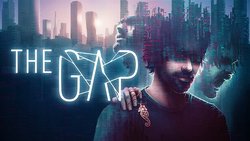
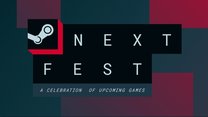
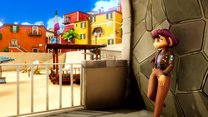




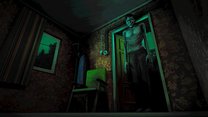

0 Comments
Want to join the discussion? Leave a comment as guest, sign in or register.
Leave a comment